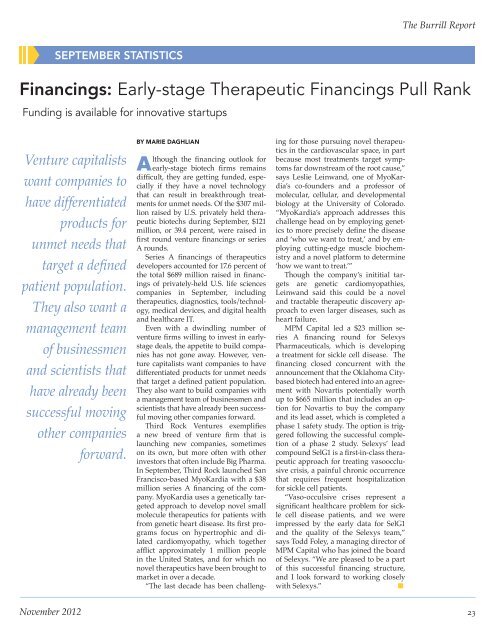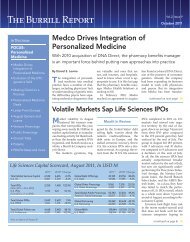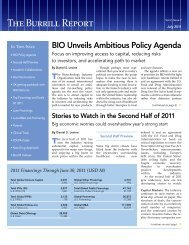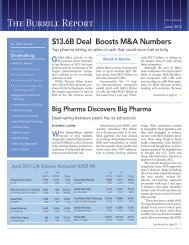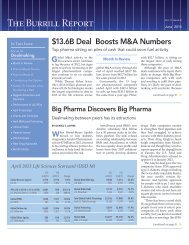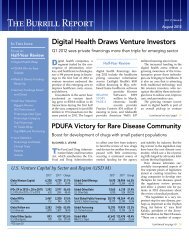Download Now - The Burrill Report
Download Now - The Burrill Report
Download Now - The Burrill Report
- No tags were found...
You also want an ePaper? Increase the reach of your titles
YUMPU automatically turns print PDFs into web optimized ePapers that Google loves.
<strong>The</strong> <strong>Burrill</strong> <strong>Report</strong>SEPTEMBER STATISTICSFinancings: Early-stage <strong>The</strong>rapeutic Financings Pull RankFunding is available for innovative startupsVenture capitalistswant companies tohave differentiatedproducts forunmet needs thattarget a definedpatient population.<strong>The</strong>y also want amanagement teamof businessmenand scientists thathave already beensuccessful movingother companiesforward.BY MARIE DAGHLIANAlthough the financing outlook forearly-stage biotech firms remainsdifficult, they are getting funded, especiallyif they have a novel technologythat can result in breakthrough treatmentsfor unmet needs. Of the $307 millionraised by U.S. privately held therapeuticbiotechs during September, $121million, or 39.4 percent, were raised infirst round venture financings or seriesA rounds.Series A financings of therapeuticsdevelopers accounted for 17.6 percent ofthe total $689 million raised in financingsof privately-held U.S. life sciencescompanies in September, includingtherapeutics, diagnostics, tools/technology,medical devices, and digital healthand healthcare IT.Even with a dwindling number ofventure firms willing to invest in earlystagedeals, the appetite to build companieshas not gone away. However, venturecapitalists want companies to havedifferentiated products for unmet needsthat target a defined patient population.<strong>The</strong>y also want to build companies witha management team of businessmen andscientists that have already been successfulmoving other companies forward.Third Rock Ventures exemplifiesa new breed of venture firm that islaunching new companies, sometimeson its own, but more often with otherinvestors that often include Big Pharma.In September, Third Rock launched SanFrancisco-based MyoKardia with a $38million series A financing of the company.MyoKardia uses a genetically targetedapproach to develop novel smallmolecule therapeutics for patients withfrom genetic heart disease. Its first programsfocus on hypertrophic and dilatedcardiomyopathy, which togetherafflict approximately 1 million peoplein the United States, and for which nonovel therapeutics have been brought tomarket in over a decade.“<strong>The</strong> last decade has been challengingfor those pursuing novel therapeuticsin the cardiovascular space, in partbecause most treatments target symptomsfar downstream of the root cause,”says Leslie Leinwand, one of MyoKardia’sco-founders and a professor ofmolecular, cellular, and developmentalbiology at the University of Colorado.“MyoKardia’s approach addresses thischallenge head on by employing geneticsto more precisely define the diseaseand ‘who we want to treat,’ and by employingcutting-edge muscle biochemistryand a novel platform to determine‘how we want to treat.’”Though the company’s inititial targetsare genetic cardiomyopathies,Leinwand said this could be a noveland tractable therapeutic discovery approachto even larger diseases, such asheart failure.MPM Capital led a $23 million seriesA financing round for SelexysPharmaceuticals, which is developinga treatment for sickle cell disease. <strong>The</strong>financing closed concurrent with theannouncement that the Oklahoma Citybasedbiotech had entered into an agreementwith Novartis potentially worthup to $665 million that includes an optionfor Novartis to buy the companyand its lead asset, which is completed aphase 1 safety study. <strong>The</strong> option is triggeredfollowing the successful completionof a phase 2 study. Selexys’ leadcompound SelG1 is a first-in-class therapeuticapproach for treating vasoocclusivecrisis, a painful chronic occurrencethat requires frequent hospitalizationfor sickle cell patients.“Vaso-occulsive crises represent asignificant healthcare problem for sicklecell disease patients, and we wereimpressed by the early data for SelG1and the quality of the Selexys team,”says Todd Foley, a managing director ofMPM Capital who has joined the boardof Selexys. “We are pleased to be a partof this successful financing structure,and I look forward to working closelywith Selexys.”nNovember 2012 23


